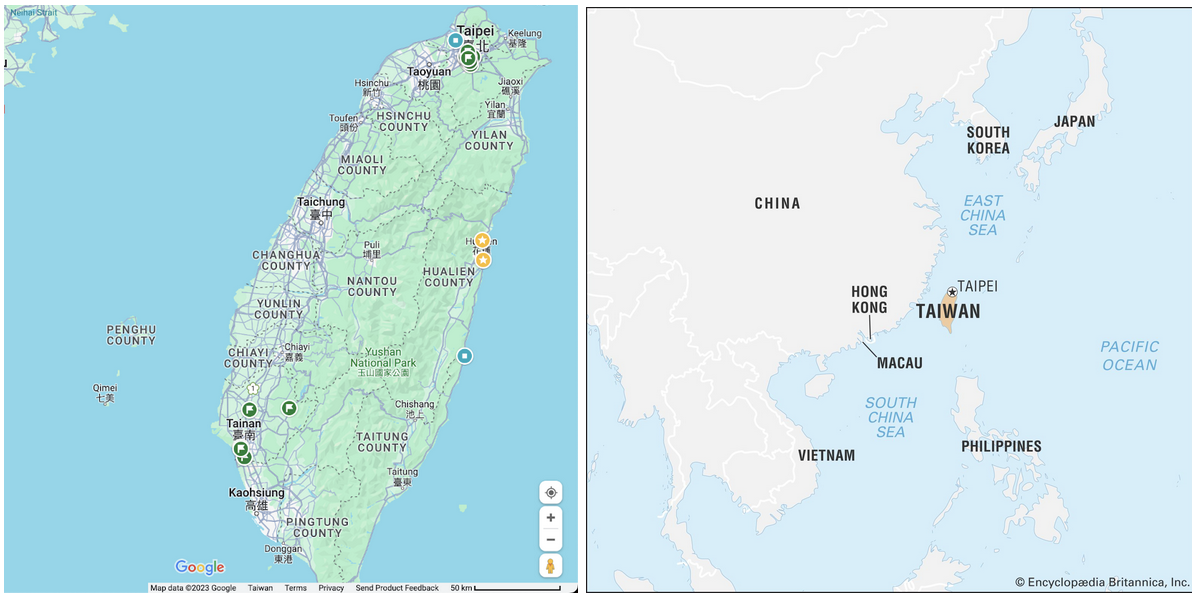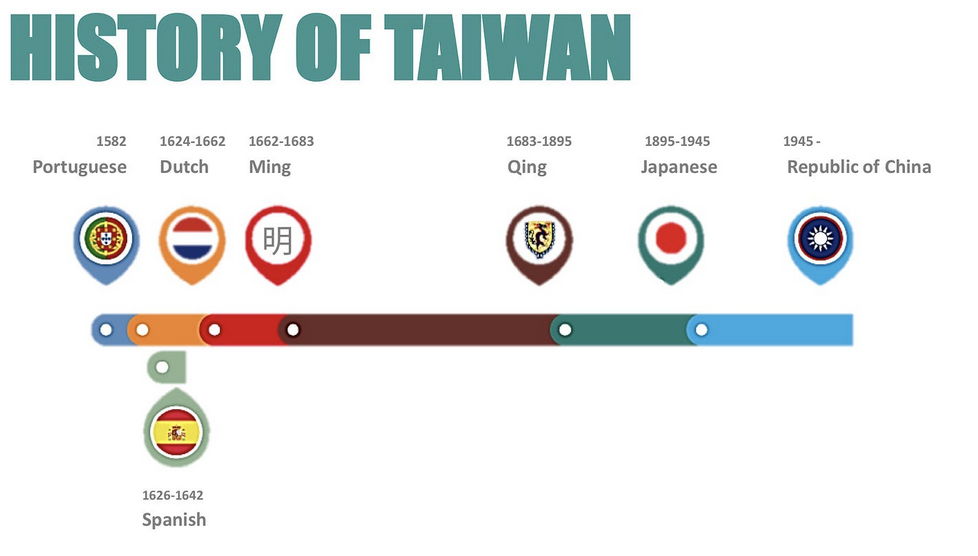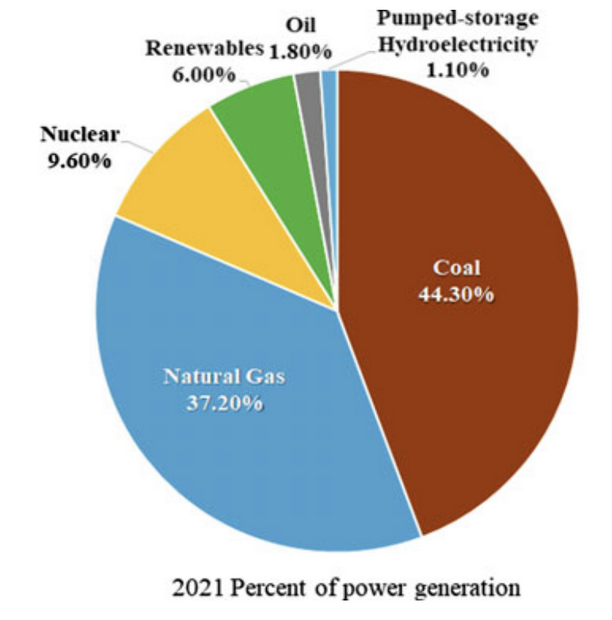Notes on Taiwan
Taiwan is young
In bullet points:
-
Around 6,000 years ago, Taiwan seems to have been settled by the ancestors of modern Taiwanese indigenous peoples. They are also the ancestors of the various indigenous peoples in Oceania (e.g. Maori, Samoans)1.
-
The first Han presence seems to have been Chinese fishermen in the islands off of Taiwan. Under the Yuan dynasty, Penghu (a small island off of Taiwan), was incorporated in 1218
-
“In 1591, Japan sent envoys to deliver a letter requesting tribute relations with Taiwan. They found no leader to deliver the letter to and returned home. In 1609, a Japanese expedition was sent to survey Taiwan. After being attacked by the Indigenous people, they took some prisoners and returned home.”
-
Prior to 1600, Taiwan was an island that most countries of the world didn’t care about.
-
Also known as ‘Formosa’ from ‘Ilha Formosa’ (‘beautiful island’) because in ~1542 some Portuguese fisherman were the first to put it on a European map.
-
Taiwan ceded by Qing dynasty to Japan in the 1895 Shimonoseki, Japanese rule for 50 years until post WW2 messiness has Chiang Kai Shek come in (1949) and set up an authoritarian dictatorship until 1987
-
First democratic presidential election in 1996


This figure regrettably leaves the arrival of the much older indigenous Taiwanese. I keep it to point out how eventful the governance of Taiwan has been in recent centuries.
Taiwan has great cinema
My favorite:
- Yi yi (2000), Edward Yang
- Multigenerational, deep stories. Gives a strong felt sense of what it is like to be a Taiwanese family circa ~1980
- A Brighter Summer’s Day (1991), Edward Yang
- Captures tragedy of gang violence in Taiwan, which has been apparent until fairly recently
Tsai Ming-leng’s Rebels of a Neon God, about a delinquent teenage romance, is bizarre and memorable.
Taiwan is unusually religious
Most countries decline in religiosity as they modernize. Not Taiwan.
From a 2019 poll, 76% of Taiwanese identified as religious: 35% call themselves Buddhist, 33% Taoist, and the rest are scattered among Protestant or Catholic religions.
These stats are somewhat misleading. People in Taiwan tend to follow a syncretic folk religion that combines Taoist, Buddhist, and Confucian entities and ancestor worship. Households will often visit both Taoist and Buddhist temples to light incense and bow in acknowledgement. Paper money will be burned for good fortune in a son’s college entrance exam etc.

Walk around the main train stations and you will frequently see a brigade of gray-robed Buddhist grannies. They are part of the Buddhist organization Tzu-chi, and their main practice is volunteering service. They have over 10 million members. My grandmother is a member, and they are great. Think effective altruism if people didn’t care so much about the utility and were mostly old Buddhist women.
I went to a conference of theirs and was stunned at the sophistication of their philanthropy. They send thousands of practitioners overseas for disaster relief (e.g. during the 2005 Indian and 2006 Pakistani earthquakes), have their own hospitals and universities, and even their own materials science research division. One of their researchers showed me a new type of recycled cloth from plastic and I have to say I was pretty damn impressed.
The presence of religion in Taiwan enlivens the culture. Between city blocks with 7-Elevens, a common sight will be an old man, getting off his motor scooter to burn some incense and pray to Guanyin or Tianzun. The recourse to prayer in response to bad luck is a powerful cultural adaptation that we could use more of, in my opinion.
Taiwan will remain heavily reliant on imported energy
The three most important energy sources for Taiwan are coal, natural gas, and oil (for transportation). Taiwanese is entirely dependent on imports for all three. In terms of energy dependence, Australia supplies the majority of coal and natural gas. Oil is mainly from the middle east. Russia and Indonesia are also nontrivial energy dependencies for Taiwan.
Here’s a comparison of the energy sources for electrical power in Taiwan.

This is bad news for resilience in the face of a conflict.
From Global Taiwan Institute: “Taiwan is 99.75 percent reliant on imported petroleum and does not have strike-resistant storage facilities or a single Strategic Petroleum Reserve (SPR) base. Instead, the responsibility for managing Taiwan’s petroleum reserves is delegated to the civilian-led oil industry. This stands in stark contrast to the SPR systems employed by Japan, South Korea, and the United States, which are managed by government agencies.”
Unfortunately, in the wake of Fukushima, nuclear energy is deeply unpopular with the Taiwanese public. Taiwan is among the most volcanically active places on earth, but the nuclear energy council report post-Fukushima
Wind turbines and solar panels are popular. A rudimentary energy estimate suggests they’d need to turn 80% of Taiwan into wind turbines to meet current power demands2. Solar panels are a bit better (more like 1/10 of all Taiwan’s land) but as with all renewables there is the problem of intermittency. I don’t think renewables are going to be a majority energy source any time soon.
Taiwanese food is unbelievably good

I’m not a great food photographer, but I was delighted at how good the $3 (100 NT) train meals are (left). One of the best things I ate was the Tainan milkfish soup (right), which was $2 (60 NT). Sweet, savory, crunchy… I don’t have a great vocabulary for food taste but if you are ever in Tainan I cannot recommend it enough.3
Final note; the people of Taiwan have always treated me with the utmost warmth and care. From the air stewardess who nodded waived the bag fees in my frantic rush with hugely overweight luggage to the old lady who walked with me for a half hour through a Taipei urban maze to find my friends’ bar to Paiwan woman who kindly walked me through how to dye leather. Deep warmth in my heart appears every time I think of the people of Taiwan. I am very grateful to have interacted with the Taiwanese culture.
Notes
-
This should come as no surprise given the striking visual resemblances between the art of e.g. the Amis and the Maori. ↩︎
-
To meet Taiwan’s annual electricity need of 261.1 TWh using wind turbines, considering an average turbine capacity of 2.5 MW and a 30% capacity factor, we’d need approximately 40,000 turbines. Assuming each turbine requires about 0.75 km² of land, including infrastructure and access, the total land area needed would be around 30,000 km². This is about 80% of Taiwan’s total land area of 36,193 km². ↩︎
-
For those looking to visit Taiwan, the Lonely Planet Guide to Taiwan is an excellent resource. ↩︎